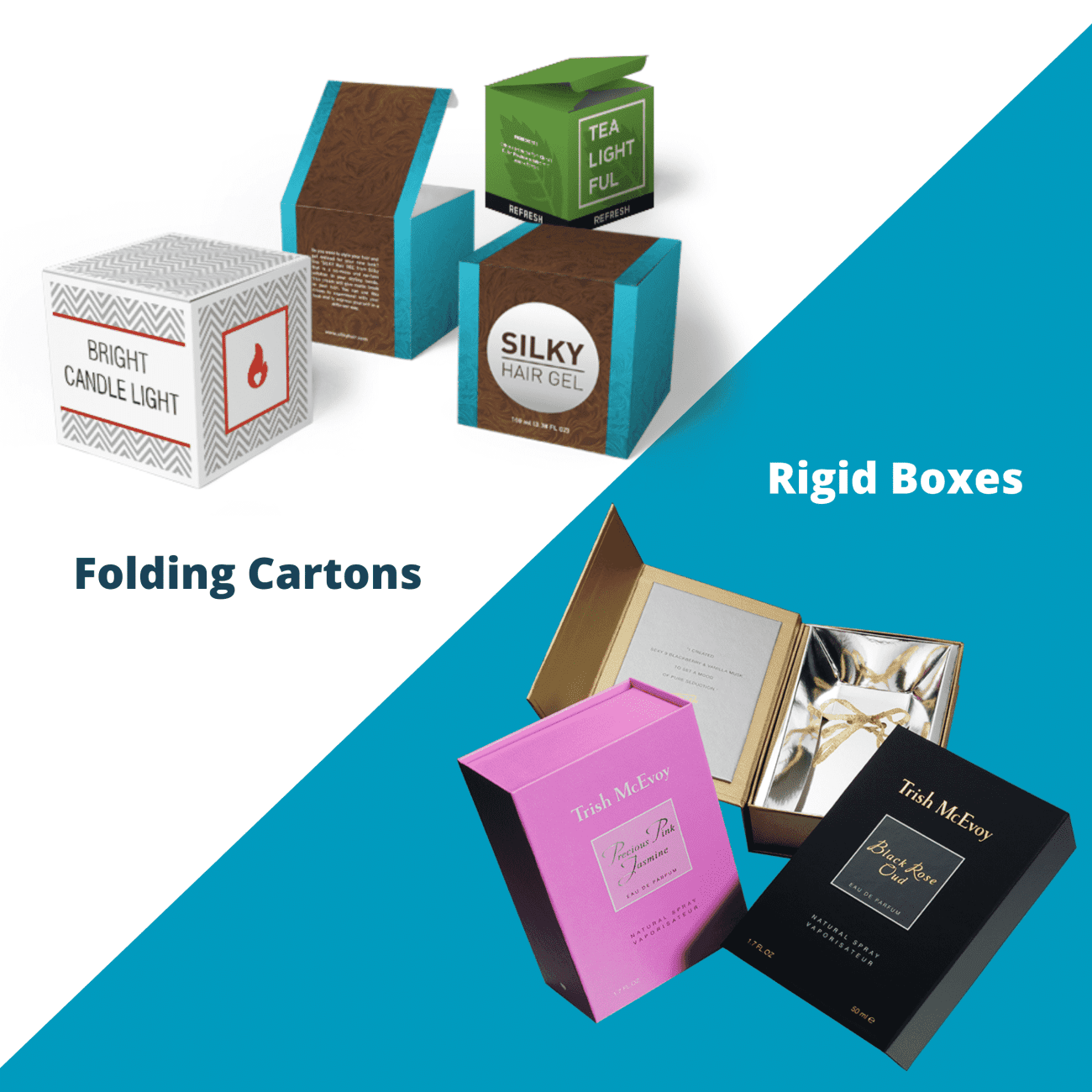Home » Folding Carton Vs Rigid Boxes: Which One Should You Choose?
Folding Carton Vs Rigid Boxes: Which One Should You Choose?

When it comes to packaging your products, the choice between folding cartons and rigid boxes is crucial. Both types serve similar purposes in protecting, displaying, and promoting products but differ significantly in their construction and usage implications. This guide provides an in-depth comparison to help you decide which packaging solution best suits your product plans, budget, and business goals.
Understanding Folding Cartons and Rigid Boxes
What is A Folding Carton?
Folding cartons are typically made from thin paperboard, precisely cut, folded, and glued to form a variety of shapes and sizes. These cartons are versatile, customizable, and widely used across various industries for lightweight, durable, and cost-effective packaging solutions.
Folding Carton Benefits
• Cheaper in costs: folding cartons are less complex and are generally made with cheaper material than rigid boxes.
• Storage space efficient: cartons have the flexibility of folding flat, which makes it ideal for storage purposes.
• Lower logistics costs: with lightweight material and a flat structure, cartons are cheap in overhead for shipping and handling.
• Faster to produce: typically, the simpler the packaging product is the faster it is able to be produced.
Folding Carton Disadvantages
• Less product protection: the material used to create folding cartons are thinner compared to rigid boxes.
• Product set-up required in fulfillment: packagers usually have to fold the carton into its form.
• Cannot hold heavy or fragile items: this type of box is not recommended in holding fragile or heavy items.
Common Folding Carton Applications
• Food snacks
• Cereal
• Small electronic devices and accessories
• Soda packs
• Medicine
• Consumer goods (small)
• Sports accessories
• Nutrition and supplements
• Ink cartridges
What is A Rigid Box?
Rigid boxes are made from heavier cardboard than folding cartons and are non-collapsible. Known for their strength and premium quality, these boxes offer enhanced protection and an elevated unboxing experience, often used for luxury or high-value products.
Rigid Box Benefits
• Higher perceived product value: rigid boxes provide customers with more confidence due to your investment in the products packaging (display and promotion)
• Product set-up is easier in fulfillment: these boxes are delivered in their box shape, which will require less labor in fulfillment.
• Superior product protection: these boxes provide extra protection compared to other boxes.
Rigid Box Disadvantages
• More expensive to make: the cost of materials and effort to make rigid boxes is substantially more than a folding carton.
• Slower to Produce: these boxes are more complex, which often result in slower production.
• Higher logistics costs: these boxes are not as logistic friendly as cartons.
• Requires more storage space: boxes have to be stacked and cannot lay perfectly flat like a foldable box.
Common Rigid Box Applications
• Gift boxes
• Cosmetic and beauty set boxes
• Medical devices
• High-end and luxury products
• Jewelry
• Smartphones and computers
Comparison and Considerations
When choosing between folding cartons and rigid boxes, consider the following aspects:
- Product Type: The nature of the product, its fragility, and value play crucial roles. Rigid boxes are preferable for delicate or premium items, while folding cartons are sufficient for more durable and lower-value products.
- Budget Constraints: Folding cartons are more budget-friendly, especially for large volumes, making them suitable for businesses looking to minimize costs.
- Brand Image: The packaging contributes significantly to brand perception. Rigid boxes often convey a higher quality image, appropriate for luxury brands or premium product lines.
- Environmental Impact: Consider the sustainability of your packaging choice. Both options can be produced with recycled materials, but the overall environmental impact may vary based on the production process and materials used.
Final Recommendation
Your decision should align with your overall marketing strategy, product requirements, and customer expectations. If presenting a luxury image or ensuring the utmost protection is crucial, rigid boxes are the best choice. However, if cost efficiency and practicality are more significant concerns, folding cartons will serve well.
If you are interested in rigid boxes or folding cartons, then partner with Brown Packaging today to get started.
Why Co-Packaging Becomes Critical During the Holidays As the holiday season approaches, packaging teams are under pressure to deliver high volumes of promotional sets, combo
Holiday demand starts long before December. So should your packaging. For B2B and D2C brands alike, Q4 is the most critical—and most chaotic—shipping window of
The Challenge of Multi-SKU Holiday Programs During the holiday season, brands often shift from selling single products to curated sets, bundled assortments, and promotional kits—each
Rigid boxes are the gold standard of premium packaging. Whether used for cosmetics, electronics, fashion, or high-end subscription kits, rigid boxes do more than protect
Understanding One-Piece FOL and Three-Piece Bike Shipping Boxes Choosing the right box style is essential when shipping bicycles—especially for brands, manufacturers, and distributors focused on
Corrugated boxes are essential to shipping, retail, and e-commerce—but when you introduce custom printing, the stakes (and the opportunities) rise. Print isn’t just about looks—it’s
Home » Folding Carton Vs Rigid Boxes: Which One Should You Choose?
Rigid boxes are the gold standard of premium packaging. Whether used for cosmetics, electronics, fashion, or high-end subscription kits, rigid boxes do more than protect
Folding cartons are a retail packaging staple—used across food, cosmetics, health, and consumer goods for their lightweight, customizable, and cost-effective structure. But not all folding
Folding cartons are one of the most versatile forms of retail packaging—and how you print on them can make the difference between a product that